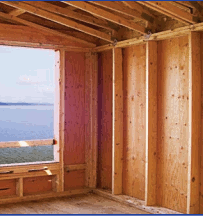
Buildings need proper levels of wall insulation.
 Wall Insulation is critical for your Home's comfort
Wall Insulation is critical for your Home's comfort As long as outdoor and indoor temperatures are different, heat will pass through the materials that make up the walls. Only insulation can prevent it.
Wall insulation is at least as important as attic, roof and floor insulation. Exterior walls involve a much wider surface, and that counts a lot.
 Levels of External Wall Insulation
Levels of External Wall InsulationThe ideal levels of insulation depend greatly on the climate where you live.
If you live in a cold climate you may need R-40 (Metric U-value: 0.14), that is, about 13 inches/32 cm of fiberglass, or 10 inches/24 cm of mineral wool. In hot climate you need a lot less.
For a Passive House approach you need more (in a cold climate): around R-50 (Metric U-value: 0.11; about: 12 inches/30cm of mineral wool).
 2x6 Walls or double 2x4 Walls Provide More Space for Insulation
2x6 Walls or double 2x4 Walls Provide More Space for Insulation Wider studs allow for thicker insulation which is especially important in cold climates.
A 2x6 stud wall allows about 5 1/2 inches of space for insulation - significantly more than 2x4 walls, but a lot less than what can be installed in double 2x4 walls.
See: Energy Efficient Walls Guide and Wood Frame Walls Performance
 Stud Insulation Is Insufficient In Wood and Steel Frame Walls
Stud Insulation Is Insufficient In Wood and Steel Frame WallsThe studs in the walls are a source of heat transfer.
Framing elements can seriously degrade the R-value of the walls (about 20% in wood framing and up to 50% in steel framing).
To reduce thermal bridging to a minimum, consider the installation of a few inches of foam or mineral wool all over the outside of the wall.
See:
Interior vs. Exterior Wall Sheathing Insulation
Thermal Bridging through the walls, floors and ceilings
Retrofit Cavity Insulation
 Exterior vs. Interior Wall Insulation
Exterior vs. Interior Wall InsulationBuildings, in most climates, should benefit from a continuous layer of insulation on the outside of their external walls (insulative sheathing)
But there are cases where that continuous layer of insulation is placed on the interior of the wall.
See: Interior vs. Exterior Wall Insulation
 Wall Insulation In Hot Climates
Wall Insulation In Hot Climates Exterior walls do not need very high levels of insulation in hot and tropical climates. 2-3 inches/5-8 cm of a rigid insulation is probably plenty.
 Insulation Costs and Materials
Insulation Costs and MaterialsIf building a new home, do not try to make savings by reducing wall insulation levels. Do it right the first time… Doing it at a later moment will cost you a lot more: retrofit insulation is a lot more expensive.
See:
Home insulation materials
Retrofit Cavity Wall Insulation
New Homes & Insulation